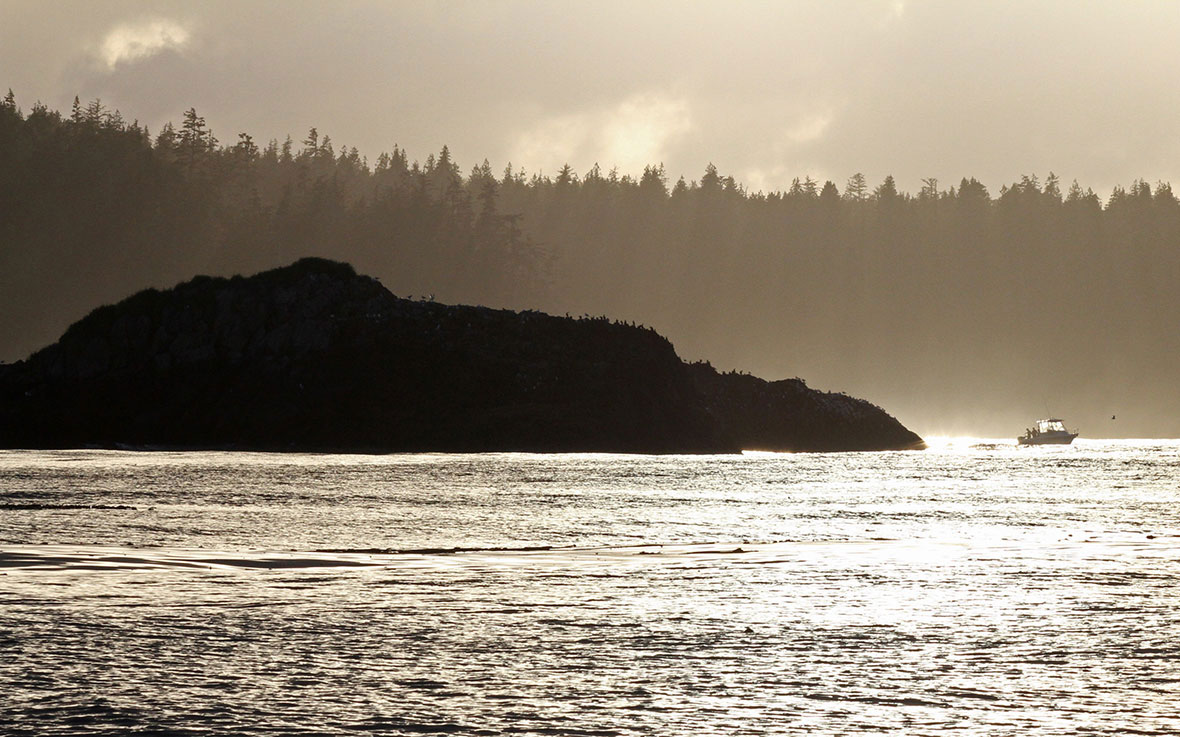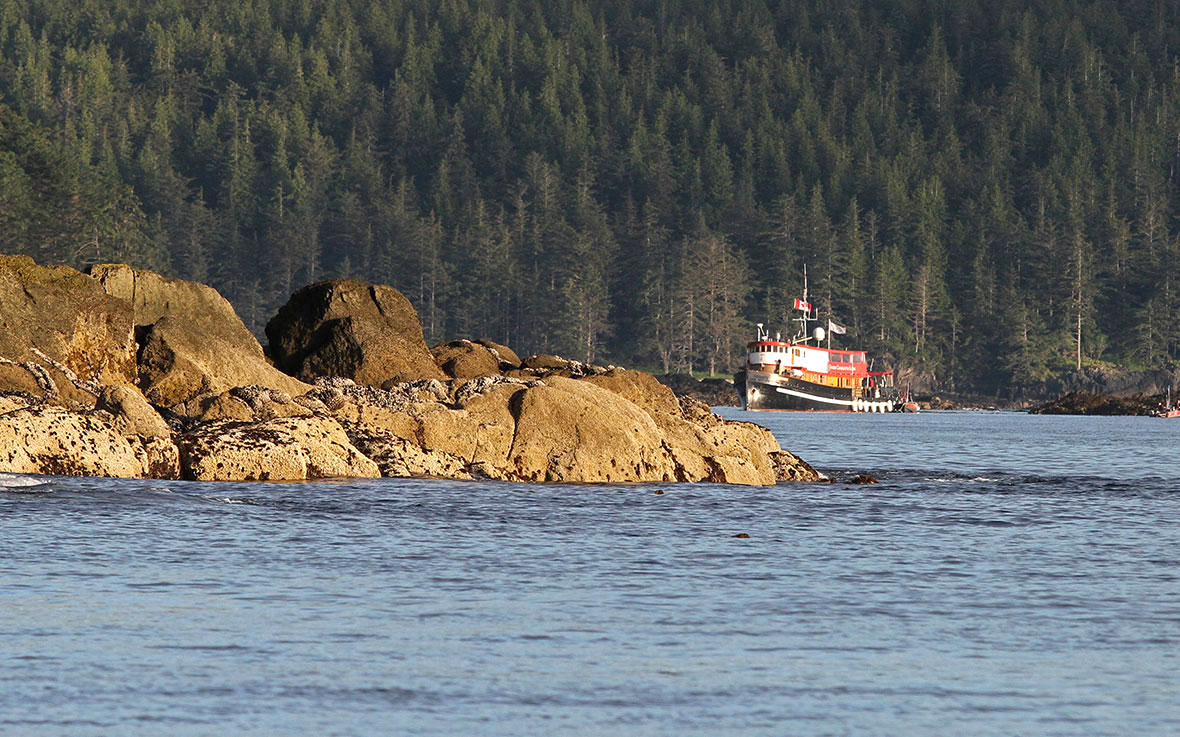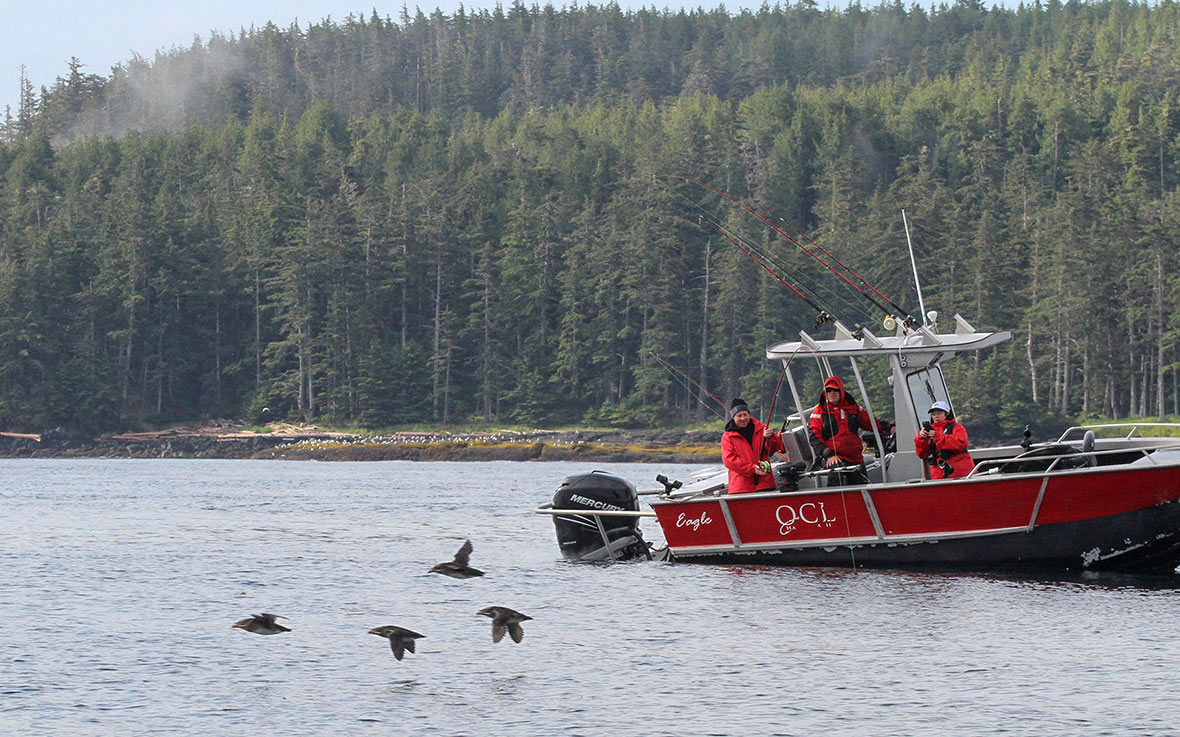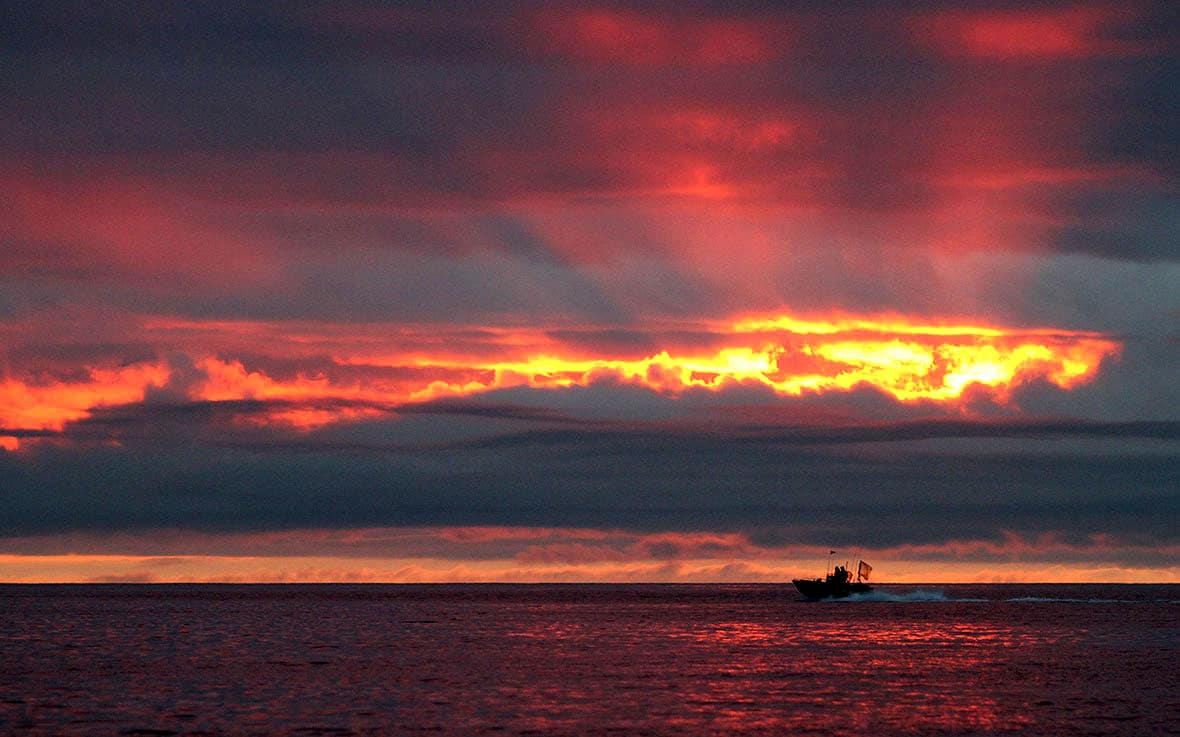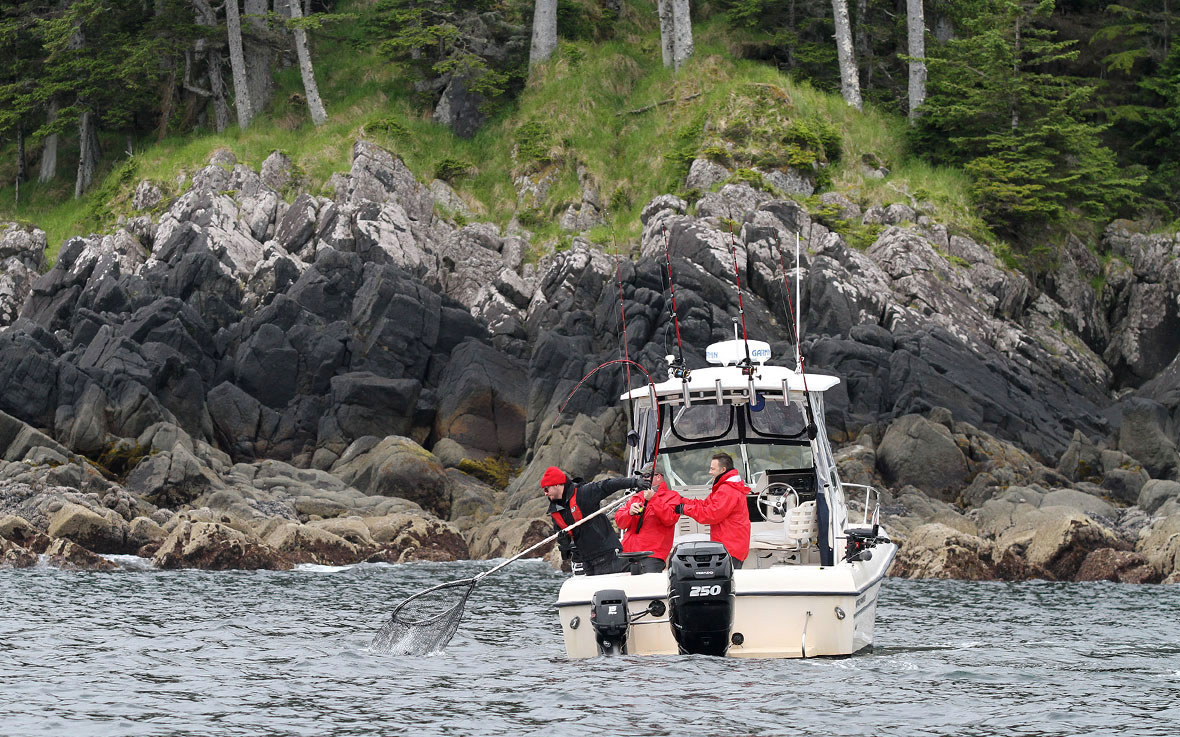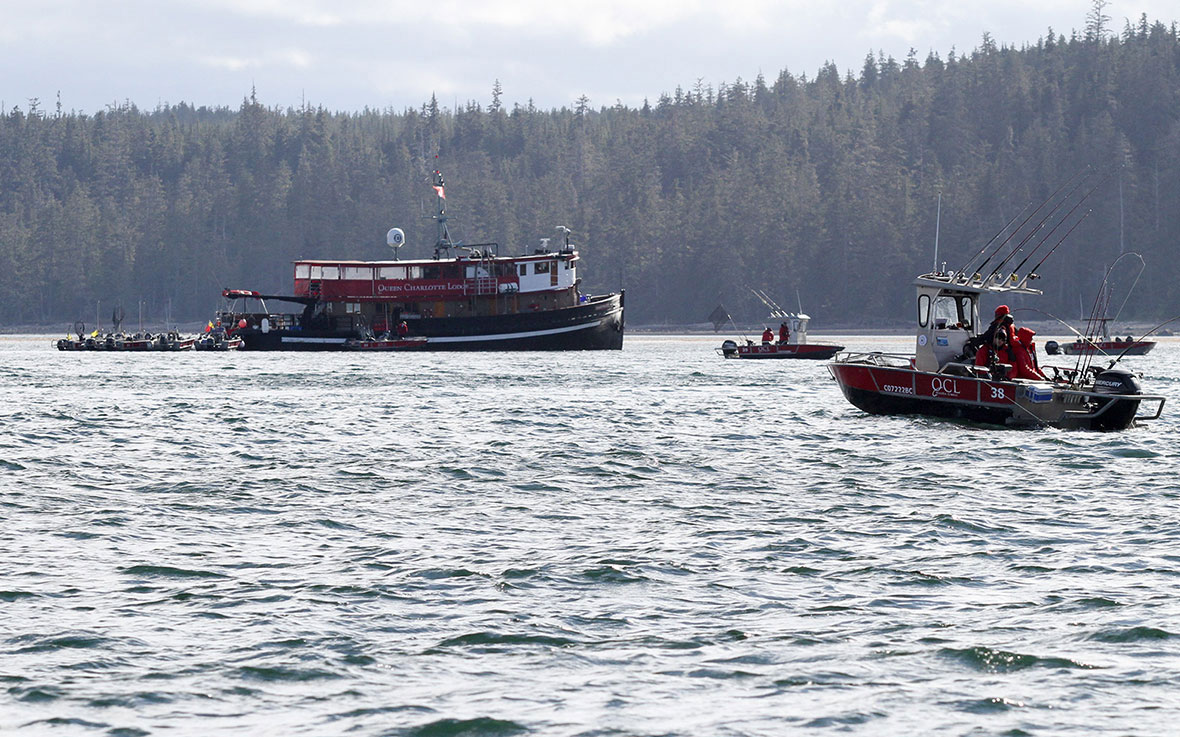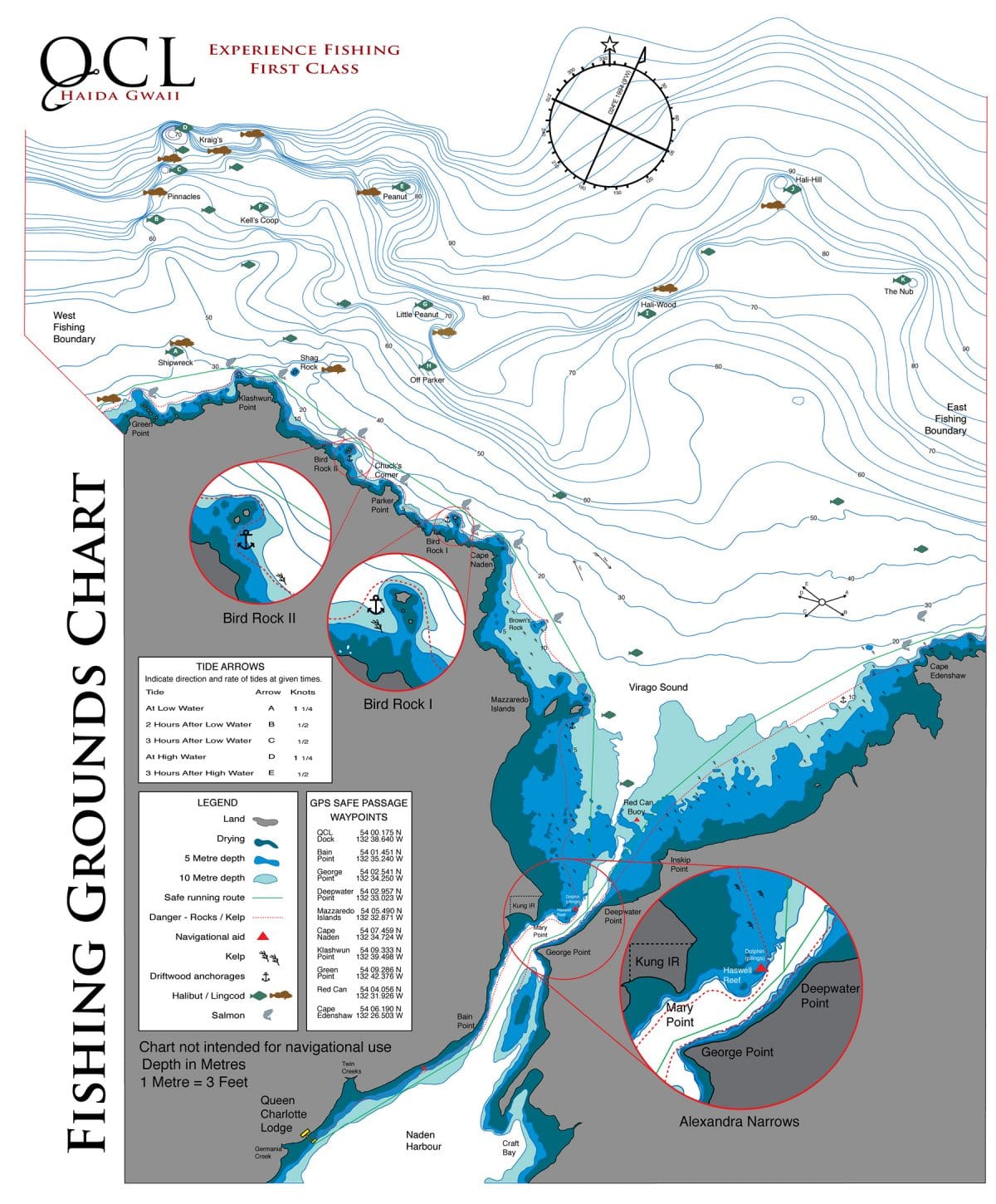Fishing Grounds
Fish Abound
Located right in the gateway to the North Pacific, our fishing grounds offer a wealth of opportunity to QCL anglers. The relatively shallow waters, full of baitfish and plankton, provide the perfect habitat for hungry salmon just beginning their homeward migration. Sheltered from the open Pacific, these fishing grounds produce an abundance of sportfish over the course of the summer that rivals any locale on the coast.
The shoreline of Virago Sound is studded with rocky outcrops forming quiet little coves along its length. Cloaked with life-giving kelp forests, and teeming with herring and needlefish, it’s salmon fishing paradise!
The orientation of Virago Sound is such that anglers are able to fish protected water under almost all wind directions and certainly all of the common summer ones. The run to the fishing grounds is only 15 minutes to Cape Naden and 10 more to Klashwun Point.
The MV Driftwood spends much of her time at anchor in the quiet water behind Bird Rock II, serving as the centre of operations during the fishing day. Those guests staying aboard the Driftwood awake each day with the unique opportunity to drop a line over the side and hook a Tyee Chinook before they even put their socks on!
Our area provides anglers the ability to fish in protected waters, unaffected by the open Pacific swells. Our fishing grounds are close by the lodge, and anglers can drop a line within 10 minutes of leaving the dock!
Halibut anglers will appreciate that much of our bottom fishing is done just a short trip from shore – no need to pack a lunch to travel offshore when you fish at QCL!
All QCL guests enjoy the Driftwood’s hospitality and services throughout the fishing day! The coffee’s always on and we serve a delicious barbeque lunch on board in “The Hook” café through mid-day.
Migration Patterns
With Chinook and Coho salmon available in large numbers, and humpback whales and orcas breaching to say hello throughout the duration of our season, it’s no wonder that this little corner of the world is renowned for its unparalleled adventure.
The waters of the northeast Pacific surrounding Haida Gwaii form one of the most productive ecosystems in the world’s oceans. As atmospheric patterns vary depending on the season, the North Pacific High is noteworthy as it is the dominant pressure system in summer. It brings northwesterly winds along the coast and an upwelling of nutrients over the continental shelf into the shallow coastal waters, creating a particularly rich and productive environment.
FOOD
Phytoplankton and zooplankton provide the base of the food pyramid in North Pacific waters. The ocean’s primary producers are tiny, single-celled phytoplankton (photo synthesizers) which convert about 1% of the sun’s energy into chemical energy. They grow and reproduce rapidly, so a small mass can have a fast rate of primary production. Zooplankton make up most of the marine animal (carnivore) biomass. As primary consumers, zooplankton are the crucial link between the primary producers (mainly phytoplankton) and the rest of the marine food web (secondary consumers like fish, crustaceans, and invertebrates.)
Herring and needlefish are major secondary consumers, feeding on various plankton. Spawning in the shallow waters of Virago Sound and Dixon Entrance, production of needlefish and herring is optimal and provides a massive food supply for top level consumers like salmon, halibut, whales, eagles, and countless seabirds. During their various life stages, salmon play different roles in food webs. Tiny salmon fry are secondary consumers, eating zooplankton and aquatic insect larvae. Adult salmon eat larger crustaceans and small fish, so are considered tertiary consumers. Salmon fry are eaten by larger fish and birds, and adult salmon are food for seals, sea lions, and resident orcas.
SALMON
The remote wilderness and geography of the northern waters offer salmon a unique gathering grounds on their annual migration. After hatching, salmon spend time growing in and around the rivers before venturing out into the open ocean. Once in the ocean, their search for prey such as herring and squid leads them north. After years of growing, they begin their journey south to return to the river they hatched in, for spawning.
Geographically, our fishing grounds are the prime spot for fish making their journey south. Situated along the north coast of Graham Island, salmon on their way to spawn, must pass through these waters. For others trying to gain their last few pounds of weight before beginning their trek, our healthy kelp beds and unique shorelines provide shelter for many of these fish to rest as they increase their strength.
HUMPBACK WHALES
Humpback whales live in all oceans around the world and travel great distances every year between their breeding habitat and their feeding grounds. The North Pacific population of several thousand, range across most of the Northeast Pacific, from the Aleutian Islands to Southeast Alaska and northern British Columbia. Most of these Humpbacks return to the Hawaiian Islands for the winter months to breed and give birth to their calves. As many as 30% of the Humpbacks we see in northern BC may migrate to Mexico.
In early spring, Humpbacks migrate to our productive, northern waters where they forage extensively on euphausiids, (shrimp-like crustaceans, krill) and small fish, straining huge volumes of ocean water through their baleen plates. As autumn approaches, having built up fat reserves during the feeding season, the whales then migrate back to their wintering grounds where little, if any, feeding takes place until they return to the north again the following spring.
ORCAS
In this lively mix, we also see three distinct ecotypes of Orca, or Killer Whale: Northern Residents, Transients (Bigg’s) and Offshores. None of the different types of orcas tend to associate with one another. The Northern Residents range from all of coastal BC up to southeast Alaska. Each pod has a unique call. Northern residents are fish-eaters, with a strong preference for Chinook salmon. They’re commonly, but irregularly, seen passing through the fishing grounds, moving parallel to the shoreline, east to west or west to east. They work together to catch their prey, often using a herding technique, and share the catch with each other. They are commonly found in social groups called pods that usually number 10 to 25 or more whales. Orcas are very social and can spend many hours intermingling with other maternal groups or other pods from different clans. Sometimes we see them congregated to form a “superpod” of 50 to 100 whales! Resident orca generally inhabit coastal waters where Chinook salmon were historically available year-round.
Bigg’s, or transient orcas, seem to come and go. As their name implies, they are transient and just pass through, covering a lot of shoreline in a single day, usually on the hunt for seals, sea lions, porpoise, and dolphin. Most commonly we see them in small family groups of less than 12 whales, usually close to shore where they can find seals around the rocks. Transients do not feed on salmon like residents do and therefore usually don’t echolocate when hunting prey since marine mammals can hear underwater. It is unclear as to their actual territory if they even have one. They can cover huge distances from Alaska down to California.
The Offshore population is much more elusive, they seldom travel into the lower inside waters of British Columbia at all. These whales spend most of their time in offshore waters of the open Pacific. Studies suggest they are fish eaters, perhaps feeding on sharks. A study published in the journal of Aquatic Biology proves through DNA evidence that Offshore Orcas prey on large Pacific sleeper sharks. The shark’s skin is abrasive and therefore wears the whales’ teeth down noticeably when compared to other resident and transient Orcas.
So, it’s easy to understand why human migration to these fabled waters is completely in line… We’re just part of a much bigger picture!
Highlights
- Fish 30 km of shoreline structure all around Virago Sound
- Fish the salmon migration gateway to the BC mainland
- Sheltered waters from most common winds
- Large habitat area for needlefish and herring attracts gamefish
- Excellent access to large populations of local groundfish
The lodge is just 15 minutes from the fishing grounds and because QCL is on the east coast of the Queen Charlottes you don’t get the 8′ to 12′ swells and rough water common on the west coast of the Queen Charlottes. My fishing partner and I will return to QCL.
~Dave M on TripAdvisor

